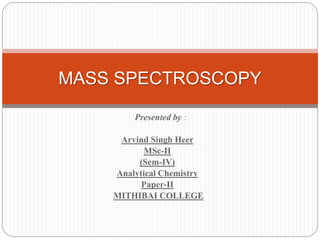
MASS SPECTROSCOPY
- 1. Presented by : Arvind Singh Heer MSc-II (Sem-IV) Analytical Chemistry Paper-II MITHIBAI COLLEGE MASS SPECTROSCOPY
- 2. CONTENT INTRODUCTION. PRINCIPLE. CORRELATION OF MASS SPECTRA WITH MOLECULAR STRUCTURE. MOLECULAR IDENTIFICATION. METASTABLE PEAKS.
- 3. INTRODUCTION Mass spectrometry is one of the most generally applicable tools providing both qualitative and quantitative information about the atomic and molecular materials. Here the compound under the investigation is bombarded with a beam of electrons which produce an ionic molecule or ionic fragments of the original species. The resulting charging particle is then separated according their masses.
- 4. PRINCIPLE Organic molecules are bombarded with electron and are converted to high energetic positively charged ions(molecular ions or parent ions). Which will break up in to smaller ions (fragment ions or daughter ions). The loss of electron from a molecule leads to a radical cation. M+e- M++2e- This molecular commonly M+ decomposes to a pair of fragments which may be either radical +anion or a small molecule + radical
- 5. These molecular ions, are isolated in the electric field at an voltage V, these charging particles which are isolated then made to enter into an magnetic field H. Here the field attracts the particles and move in a circle around it. Here the radius of the ionised molecule depends on m, its mass. This forms the basis of separation of particles according to their masses. These ions are made to impinge upon the collector in turn thus giving rise to a spectrum. The ion source, ion path and collector of the
- 6. CORRELATION OF MASS SPECTRA WITH MOLECULAR STRUCTURE The ionization efficiency of a mass spectrometer source must be high so that a large portion of the neutral sample particles present are converted to ions. High efficiency is particularly important for the analysis of nanogram quantities of sample material and trace impurities in solids. When bombarded by e- in the electron-impact method of ionization, every substance ionizes and fragments uniquely. A molecule may simply lose an e- of many fragments into two smaller units, an ionized
- 7. A molecular ion is generally observed in considerable intensity when the gaseous molecules are bombarded with e- of energy just sufficient to cause ionization, but not bond leakage, about 8- 14eV for most organic molecules. As soon as the excess energy over the ground state energy possessed by the molecular ion becomes equal to the dissociation energy of some particular bond, the appropriate fragment ions are formed. Although the peak intensities are extremely sensitive to ionizing voltage at low values of ionizing voltage, the relative peak intensities become fairly constant once the ionization voltage exceeds 50eV. At higher ionizing energies the total production of ions is higher, but the net effect of higher overall intensity and the resultant severe fragmentation is
- 8. MOLECULAR IDENTIFICATION In the identification of a compound, the most important information is the molecular weight. The mass spectrometer is unique among analytical methods in being able to provide this information very accurately, often to four decimal places when a high-resolution mass spectrometer is used. At ionizing voltages ranging from 9-14V in the electron-impact mode of ionization, it is assumed that no ions, heavier than the molecular ion form. Therefore, the mass of the heaviest ion, exclusive of isotopic contributions, gives the nominal molecular weight with lo-resolution mass spectrometers and the exact molecular weight
- 9. The no. of possible molecular formulas is restricted by a study of relative abundances of natural isotopes for different elements at masses one or more units larger than the parent ion. Observed values are compared with those calculated for all possible combinations of the naturally occurring heavy isotopes of the elements. For a compound CwHxOzNy a simple formula allows one to calculate the percent of the heavy isotope contributions from a monoisotopic peak, PM, to the PM+1 peak. 100 PM+1/PM = 0.015x + 1.11w + 0.37y + 0.037z
- 11. METASTABLE PEAKS A one-step decomposition process may be indicated by an appropriate metastable peaks in the mass spectrum. Metastable peaks arise from ions that decompose in the field-free region after they are accelerated out of the ion source but before they enter the analyzer. Their life time is about 10^-6 sec. A metastable ion transition takes the general form: original ion daughter ion + neutral fragment The metastable peak m* appears as a weak, diffuse peak, usually at a nonintegral mass, given by, m* = (mass of daughter ion)^2 / mass of
- 12. In a spectrum that is linear with respect to mass values, the distance of m*, below the daughter ion is of similar magnitude to the distance of the daughter ion below the original ion. The foregoing relationship holds only for ions that decompose in a small portion of the accelerating region and is more frequently observed with 60 degree and 90 degree sector instruments where a field-free region exists after the accelerating slits and before the magnetic analyzer. Of course, the absence of a metastable peak from the spectrum does not preclude a particular decomposition.
